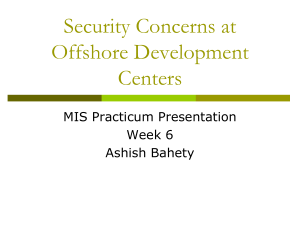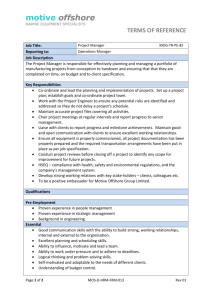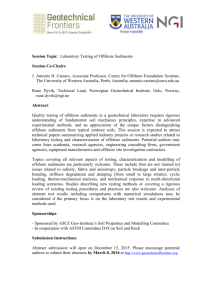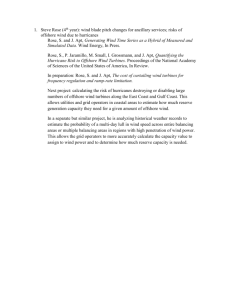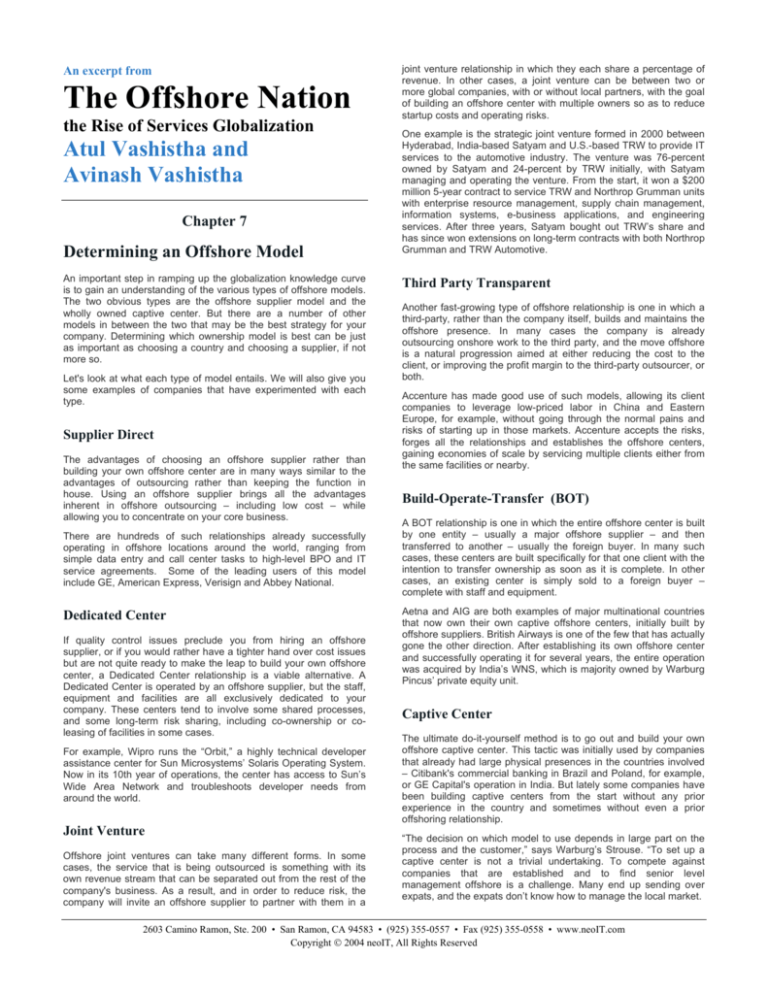
An excerpt from
The Offshore Nation
the Rise of Services Globalization
Atul Vashistha and
Avinash Vashistha
Chapter 7
Determining an Offshore Model
An important step in ramping up the globalization knowledge curve
is to gain an understanding of the various types of offshore models.
The two obvious types are the offshore supplier model and the
wholly owned captive center. But there are a number of other
models in between the two that may be the best strategy for your
company. Determining which ownership model is best can be just
as important as choosing a country and choosing a supplier, if not
more so.
Let's look at what each type of model entails. We will also give you
some examples of companies that have experimented with each
type.
Supplier Direct
The advantages of choosing an offshore supplier rather than
building your own offshore center are in many ways similar to the
advantages of outsourcing rather than keeping the function in
house. Using an offshore supplier brings all the advantages
inherent in offshore outsourcing – including low cost – while
allowing you to concentrate on your core business.
There are hundreds of such relationships already successfully
operating in offshore locations around the world, ranging from
simple data entry and call center tasks to high-level BPO and IT
service agreements. Some of the leading users of this model
include GE, American Express, Verisign and Abbey National.
Dedicated Center
If quality control issues preclude you from hiring an offshore
supplier, or if you would rather have a tighter hand over cost issues
but are not quite ready to make the leap to build your own offshore
center, a Dedicated Center relationship is a viable alternative. A
Dedicated Center is operated by an offshore supplier, but the staff,
equipment and facilities are all exclusively dedicated to your
company. These centers tend to involve some shared processes,
and some long-term risk sharing, including co-ownership or coleasing of facilities in some cases.
For example, Wipro runs the “Orbit,” a highly technical developer
assistance center for Sun Microsystems’ Solaris Operating System.
Now in its 10th year of operations, the center has access to Sun’s
Wide Area Network and troubleshoots developer needs from
around the world.
Joint Venture
Offshore joint ventures can take many different forms. In some
cases, the service that is being outsourced is something with its
own revenue stream that can be separated out from the rest of the
company's business. As a result, and in order to reduce risk, the
company will invite an offshore supplier to partner with them in a
joint venture relationship in which they each share a percentage of
revenue. In other cases, a joint venture can be between two or
more global companies, with or without local partners, with the goal
of building an offshore center with multiple owners so as to reduce
startup costs and operating risks.
One example is the strategic joint venture formed in 2000 between
Hyderabad, India-based Satyam and U.S.-based TRW to provide IT
services to the automotive industry. The venture was 76-percent
owned by Satyam and 24-percent by TRW initially, with Satyam
managing and operating the venture. From the start, it won a $200
million 5-year contract to service TRW and Northrop Grumman units
with enterprise resource management, supply chain management,
information systems, e-business applications, and engineering
services. After three years, Satyam bought out TRW’s share and
has since won extensions on long-term contracts with both Northrop
Grumman and TRW Automotive.
Third Party Transparent
Another fast-growing type of offshore relationship is one in which a
third-party, rather than the company itself, builds and maintains the
offshore presence. In many cases the company is already
outsourcing onshore work to the third party, and the move offshore
is a natural progression aimed at either reducing the cost to the
client, or improving the profit margin to the third-party outsourcer, or
both.
Accenture has made good use of such models, allowing its client
companies to leverage low-priced labor in China and Eastern
Europe, for example, without going through the normal pains and
risks of starting up in those markets. Accenture accepts the risks,
forges all the relationships and establishes the offshore centers,
gaining economies of scale by servicing multiple clients either from
the same facilities or nearby.
Build-Operate-Transfer (BOT)
A BOT relationship is one in which the entire offshore center is built
by one entity – usually a major offshore supplier – and then
transferred to another – usually the foreign buyer. In many such
cases, these centers are built specifically for that one client with the
intention to transfer ownership as soon as it is complete. In other
cases, an existing center is simply sold to a foreign buyer –
complete with staff and equipment.
Aetna and AIG are both examples of major multinational countries
that now own their own captive offshore centers, initially built by
offshore suppliers. British Airways is one of the few that has actually
gone the other direction. After establishing its own offshore center
and successfully operating it for several years, the entire operation
was acquired by India’s WNS, which is majority owned by Warburg
Pincus’ private equity unit.
Captive Center
The ultimate do-it-yourself method is to go out and build your own
offshore captive center. This tactic was initially used by companies
that already had large physical presences in the countries involved
– Citibank's commercial banking in Brazil and Poland, for example,
or GE Capital's operation in India. But lately some companies have
been building captive centers from the start without any prior
experience in the country and sometimes without even a prior
offshoring relationship.
“The decision on which model to use depends in large part on the
process and the customer,” says Warburg’s Strouse. “To set up a
captive center is not a trivial undertaking. To compete against
companies that are established and to find senior level
management offshore is a challenge. Many end up sending over
expats, and the expats don’t know how to manage the local market.
2603 Camino Ramon, Ste. 200 • San Ramon, CA 94583 • (925) 355-0557 • Fax (925) 355-0558 • www.neoIT.com
Copyright 2004 neoIT, All Rights Reserved






